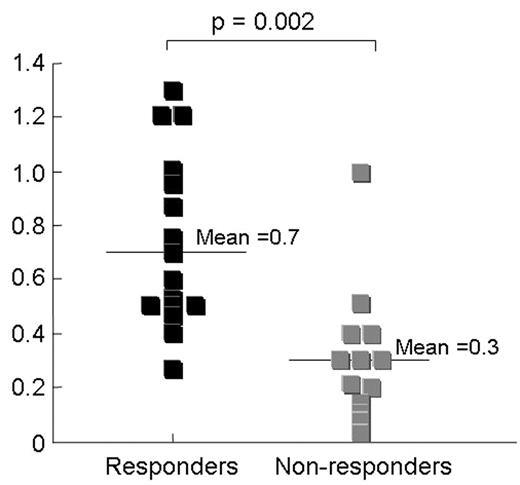Abstract
Clinical observations and experimental evidence link bone marrow failure in myelodysplastic syndrome (MDS) with a T cell-dominated immunologically-mediated pathophysiology in some patients. Indeed, among 129 patients treated with immunosuppression at NIH, trisomy 8 was associated with hematologic response to immunosuppression. We have demonstrated that trisomy 8 patients have oligoclonal CD8 T cell expansion, as determined by increased proportions of one or more T cell receptor (TCR) V beta subfamilies (
Sloand et al. Blood 106:841; 2005
) which had cytotoxic activity toward trisomy 8 cell progenitors. Here we examine the response of cytotoxic T cells to cyclin D1 and Wilms tumor protein (WT-1); these candidate autoantigens had earlier been observed to be over-expressed in trisomy 8 CD34 cell in our microarray analysis (Chen et al. Blood 104:4210, 2004 ). Bone marrow mononuclear cells from 19 trisomy 8 patients (defined by cytogenetics and FISH) had significantly increased levels of WT-1 mRNA and protein expression compared to normal CD34 cells by real time PCR and immunoblot, respectively (p<0.001). When patient and control CD8 cells were cultured in the presence of WT-1- and cyclin D1-loaded HLA-A2-restricted antigen-presenting cells (using three different HLA-A0201- restricted epitopes of WT-1 and four different epitopes for CD1), eight patients’ CD8 cell tested positive for interferon gamma, indicating a cytotoxic response. Staining with labeled MHC class I A2-restricted tetramers used to measure WT-1-specific cells showed concordant results in all eight patients. Tetramer staining was increased in 12 of 14 trisomy 8 patients examined. Cytotoxic T cells specific for WT-1 were present within the expanded V β subfamilies previously found to suppress trisomy 8 cell proliferation in vitro. CD8 cells from another eight MDS patients without trisomy 8 but who had responded to immunosuppression, sampled prior to treatment, also demonstrated WT1-specific cytotoxic activity, but only two of 18 non-responders showed measurable levels of WT-1-specific cytotoxic T cells (entire treated cohort seen in Fig 1). We infer from these data an autoimmune pathophysiology for trisomy 8 MDS with: 1) over-expression of WT-1 by the aneuploid clone; 2) a specific cytotoxic CD8 T cell immune response to WT-1; 3) subsequent cytotoxic T cell marrow suppression by apoptosis, either by cross reactivity or a bystander effect; and 4) improvement in hematopoiesis after immunosuppression. Other MDS which is responsive to immunosuppression may also be mediated by WT1.Disclosure: No relevant conflicts of interest to declare.
Author notes
*
Corresponding author
2006, The American Society of Hematology
2006


This feature is available to Subscribers Only
Sign In or Create an Account Close Modal